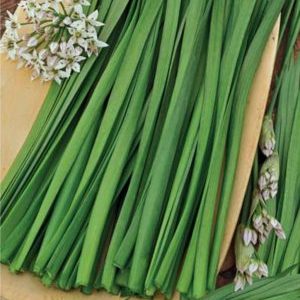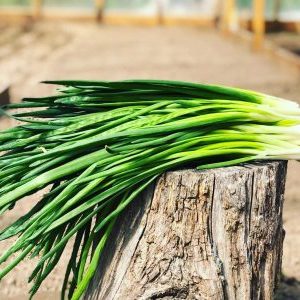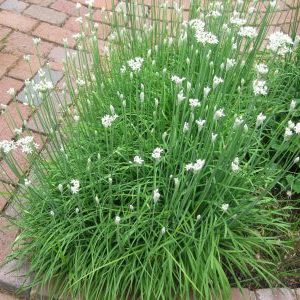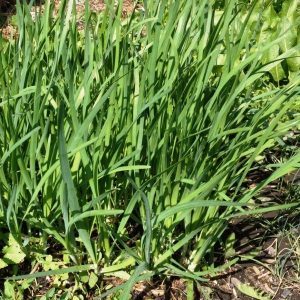Perennial onion with a pleasant scent "Jusai"
Jusai onion, which is also called scented or Chinese, comes from eastern countries. The culture is popular all over the world. Gardeners grow it for the sake of greenery, which not only has an excellent taste and bright pleasant aroma, but is also rich in vitamins and minerals.
The content of the article
Description

Jusai belongs to the Branched Onion (fragrant) species. It is widely used in cooking: it is consumed fresh, added to salads, pickled, canned, dried, frozen, used as a seasoning for meat and fish, and even used in inflorescences in winemaking.
Jusai is also used in medicine due to its chemical composition and beneficial properties.
Origin and development
The homeland of this bow is considered modern China and Mongolia, but over time it spread throughout the world. The State Register of Russia includes several varieties of allspice onions - Aromatny, Vostochny, Aprior, Benefis, Piquant and Jusai proper. The latter was included in the register in 2003, the originator was the Kuban State Agrarian University named after I. T. Trubilina ".
Chemical composition, trace elements and vitamins and beneficial properties
The calorie content of onions is 40-41 kcal per 100 g. Jusai contains:
- carbohydrates - 8.2-8.4 g;
- proteins - 1.4-1.5 g;
- fats - 0.2 g;
- dietary fiber - 0.8-0.9 g;
- beta-carotene - 1 mg;
- vitamin C - 4.8 mg;
- vitamin B5 - 0.1 mg;
- vitamin E - 0.02 mg;
- vitamin B3 - 0.28 mg;
- vitamin B6 - 0.13 mg;
- potassium - 120-123 mg;
- sodium - 27-29 mg;
- calcium - 18-22 mg;
- magnesium - 8.5-9.5 mg;
- iron - 0.26-0.28 mg;
- zinc - 0.12-0.15 mg;
- manganese - 0.08 mg;
- selenium - 0.5 mg;
- copper - 0.06 mg.
The plant is useful to include in your diet for people suffering from heart disease, neurasthenia, gastritis. Onions effectively fight colds and respiratory diseases, have bile and diuretic properties, and its juice has a beneficial effect on skin regeneration, helps relieve inflammation from insect bites.
Ripening period and yield
This is a late ripening onion - 45-48 days pass between the spring regrowth of leaves and the first cut.
The marketable yield of Dzhusay is 4-4.5 kg per 1 sq. m.
Reference. During the season, onions can be cut 2-3 times, the last cut is carried out two months before frost.
Disease resistance
Subject to compliance with agrotechnical requirements, onions are resistant to diseases, but in some cases they are affected by powdery mildew and pests such as onion moth, onion fly, and nematodes.
Characteristics of the bulb, description of the appearance, taste

Jusai onions form narrow (1.5-2 cm in diameter) false bulbs. It has long (25-30 cm) and narrow (5-7 mm) flat leaves of bright green color, covered with a thin layer of waxy coating. During the flowering period, small white flowers with a spicy aroma appear on the plants.
The bulbs do not have a pronounced taste, most often the aerial parts of plants - leaves and arrows - are used for food. They have a delicate texture, mild taste and garlic aroma.
For which regions it is best suited and what is the exacting climate
The variety is undemanding to climatic conditions, tolerates drought and light frosts well, therefore it is suitable for growing in all regions.
The main advantages and disadvantages of the variety
The main advantages of Dzhusay are:
- unpretentiousness to care and growing conditions;
- pleasant taste;
- versatility of use;
- resistance to drought, frost, disease and pest attacks;
- high productivity.
There are no shortcomings in the variety.
What is the difference from other varieties
Comparison of varieties of allspice is presented in the table:
| Variety | Maturation class | Productivity, kg per 1 sq. m. | Taste |
| Jusai | Late maturing | 4-4,5 | Mild with garlic aroma |
| A priori | Mid-season | 2,4 | Weakly sharp, weakly chalky |
| Fragrant | Early ripe | 4,8 | Weakly sharp, garlic |
| Spicy | Mid-season | 2,7 | Semi-sharp, slightly chaff |
Features of planting and growing
In order for the cultivation of Jusai to bring a positive result, observe the basic principles of the preparation of planting material, the timing and scheme of its planting.
You can grow onions by dividing the rhizomes or from seedlings, after sowing the seeds.
Preparing for landing
Seeds for seedlings require preliminary preparation:
- soak for 8 hours in water heated to + 40 ° C, constantly maintaining this temperature;
- after the indicated time, leave the seeds in lukewarm water for 48 hours.
The soil is dug up and fertilized in the fall, adding 10 liters of humus, 20 g of potash fertilizers, 200 g of ash, 30 g of superphosphate per 1 sq. m. At the beginning of spring, re-digging is carried out and 5 g of ammonium nitrate is added per square meter. m.
Ground requirements
Jusai grows well in any soil, except sandy. In this case, the onion grows tasteless, and its shelf life is significantly reduced.
Light, fertile soil with weak or neutral acidity, good moisture and air permeability is ideal. The best option is black soil, but peat bogs and loams are also acceptable.
Timing, scheme and landing rules
The process of growing seedlings from seeds:
- Prepare the soil mixture by mixing equal parts of garden soil, peat and sand.
- Disinfect it by spilling it with a solution of potassium permanganate or heating it in the oven at a temperature of + 180 ° C for half an hour.
- Pour the prepared soil mixture into the selected container.
- Make sowing furrows in the ground and place seeds in them every 3 cm.
- Cover the seeds with soil and slightly moisten it.
- Cover the container with polyethylene to create a greenhouse effect and store in a well-lit, cool place.
Seedlings are grown for about two months, and when 3-4 leaves are formed on the sprouts, they are transplanted into open ground. Most often this is done in March-April, when the air temperature is + 2 ° C, according to the following scheme:
- Make furrows on the plot at a distance of at least 30 cm from each other.
- Water the ground abundantly.
- Make planting holes in the furrows every 20 cm.
- Place the sprouts in the holes, sprinkle them with earth without tamping it, water abundantly.
If we are talking about dividing the bush, then it is carried out in spring or autumn, choosing the most developed, strong and healthy bulbs.
The work algorithm is as follows:
- Dig up an onion socket at least 3 years old.
- Divide it into several parts so that each one has several developed and strong bulbs.
- Make 5-8 cm deep furrows in the soil and water the soil abundantly.
- Place the plots at a distance of about 20-30 cm from each other.
- Water the planted plants abundantly with warm, settled water.
In some areas, seeds are planted directly into open ground, maintaining a distance between rows of 20-30 cm, deepening the planting material by 1-1.5 cm and sprinkling it with earth and humus on top. They do this in early to mid-March.
Reference. The seedless method is rarely used due to poor germination.
Growing features
It is better to plant Jusai on the western or eastern side of the site - this way the plants will have enough light for good development, but direct sunlight will not dry out the soil and burn the leaves.
It is not recommended to plant onions after potatoes and cabbage, the best predecessors for it are legumes and pumpkin crops.
Experienced gardeners change the place where onions are grown every five years.
The nuances of care
Dzhusay is unpretentious, but needs minimal care, which consists in watering and fertilizing.
Watering mode
In the first year of planting, onions are rarely watered, only as needed - this contributes to better rooting of plants.
In the second year, they water more often - at least 10 times per season, while the water consumption is 30-50 liters per 1 sq. m. In case of a lack of moisture, the feathers become rough and lose their juiciness.
Loosening the soil and weeding
The soil between the rows is weeded weekly, getting rid of weeds that take nutrients from the soil and retain water on the surface, preventing it from accessing the roots. All this negatively affects the development of the onion and reduces its immunity.
Simultaneously with weeding, the soil is loosened to a depth of 5-8 cm. This procedure enriches the soil with oxygen and nutrients, improves air exchange, and enhances the growth and development of root shoots.
Top dressing
In the first year of planting, onions are fed twice:
- in spring, after the emergence of sprouts - urea (1 tsp per 1 sq. m.) and spraying plants with a solution of "Epin Extra";
- in two weeks - treatment with "Ferovit" to improve photosynthesis.
In the second and subsequent years, in the spring, Dzhusai is fertilized with a solution of chicken manure diluted in a ratio of 1:12, and after each feather cut, complex mineral fertilizers are introduced into the soil.
After complete harvesting, the soil is fertilized with a mixture of potassium chloride, ammonium nitrate and superphosphate - this helps to strengthen the onion immunity and prepares it for winter.
Disease and pest control
To reduce the risk of disease and pests:
- use quality planting material;
- monitor watering, avoiding waterlogging of the soil;
- consider the rules of crop rotation;
- process seeds before sowing.
If the onion shows signs of powdery mildew, it is sprayed with Profit Gold or other fungicides; insecticides help get rid of pests.
Harvesting and storage
Jusai's feathers are harvested in his second year cultivation.
How and when to collect
The first cut is carried out at the end of July, the last in the second half of August. Leaves are cut, reaching 25-30 cm in length.
In the case of cleaning the main bulbous bushes from the beds, they are carefully dug in and removed from the roots. If the soil is dry, simply shake off the onion, otherwise it is washed and dried in the open air.
Storage features and keeping quality of the variety
Cut greens are stored in the refrigerator without loss of taste and useful properties for 10-12 days, frozen (at a temperature of -15 ... -18 ° C) - throughout the year.
The dug out bulbs are placed in a prepared container and removed to a dry room with good ventilation and an air temperature of 0 ... + 2 ° C - this way they will retain their technical qualities and are suitable for spring planting.
What can be the difficulties in growing
Possible problems in the cultivation of Jusai:
- the appearance of stains or streaks on the leaves that resemble rust - the result of watering with hard, not settled water;
- development of powdery mildew - in case of excessive watering or heavy rainfall;
- decay and decay of the crop sent for storage - the room is too warm, the maximum permissible temperature is not higher than + 2 ° C.
Tips from experienced gardeners
Farmers recommend:
- In the first year, do not water the onions too often - a slight drought is better for the formation of the root system than waterlogging.
- Place the plantings in the shade of trees - this gives the bow the necessary shading.
- If the seeds do not germinate or the seedlings have grown weak, then after transplanting them into open ground, cover the beds with polyethylene to maintain the necessary moisture and heat.
Reviews of the Jusai onion variety
Those who have been growing Jusai onions for a long time speak only positively about it.
Vera, Barnaul: «Several years ago, on one of the forums, I read about Dzhusai and decided to plant him. I must note that it is completely unpretentious, except that it grows poorly on sandy ground. I liked the variety because the harvest can be harvested several times per season, so in summer there is always fresh greens on the table. It is not stored fresh for long, so I put it in portioned bags and freeze it. It makes incredibly tasty manti - the whole family eats them with pleasure. "
Margarita, Bryansk: “I have known Dzhusai for a long time - this onion grows with our neighbor, and every year she treated us to delicious and aromatic greens. I am not a very experienced gardener, so I did not dare to plant it myself for a long time, but a couple of years ago I took a chance and I will say one thing - it is incredibly easy to grow it, I didn’t even think that there are such unpretentious crops. I like everything in onions - yield, taste, unpretentiousness. The only pity is that fresh greens are not stored much ”.
Read also:
Step by step instructions: how to grow leek seedlings.
The best advice on how to prepare onions for the winter.
Why is Yalta onion so good and how to distinguish it from a fake.
Conclusion
Jusai is a late ripening onion suitable for growing in all regions. It is distinguished by its unpretentiousness to soil and lighting, is resistant to drought, frost, diseases and pests and is able to produce rich yields of tasty and healthy greens even with minimal maintenance.